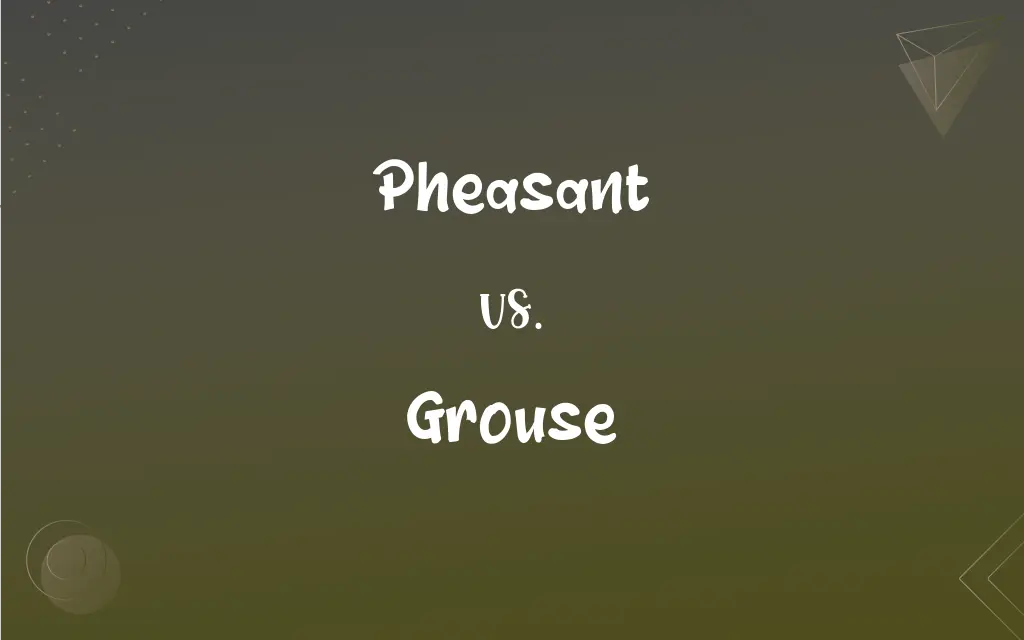Pheasant vs. Grouse: What's the Difference?
Edited by Harlon Moss || By Janet White || Published on February 20, 2024
Pheasant is a large, colorful bird, often with long tails, known for their display and game value. Grouse is a smaller, less colorful bird, adapted to colder climates, known for ground-dwelling habits.

Key Differences
Pheasants are known for their bright colors and long tails, often seen in open fields. Grouse are less colorful, with a plump body and feathered legs, adapted for cold climates.
Pheasants are often bred for hunting and are not native to North America. Grouse are native to North America and Europe, living in forests and moorlands.
Pheasants typically have a more pronounced sexual dimorphism, with males being more colorful. Grouse, on the other hand, have more subdued colors for camouflage.
Pheasants are often associated with open field habitats. In contrast, grouse are known for their preference for wooded or dense brush areas.
Pheasants are often used in game hunting and have been introduced worldwide for this purpose. Grouse are known for their unique mating displays, like the drumming of male grouse.
ADVERTISEMENT
Comparison Chart
Appearance
Large, colorful, long tails
Smaller, less colorful, feathered legs
Habitat
Open fields, grasslands
Forests, moorlands, colder regions
Native Regions
Originally from Asia, introduced worldwide
Native to North America and Europe
Behavior
Often bred for hunting
Known for ground-dwelling and mating displays
Pheasant and Grouse Definitions
Pheasant
A bird often bred for sport hunting.
The estate raised pheasants for their annual hunting events.
ADVERTISEMENT
Grouse
A compact, ground-dwelling game bird.
The grouse scurried through the underbrush, well-camouflaged by its surroundings.
Pheasant
A species often found in agricultural lands and open fields.
Farmers often encountered pheasants while working in their fields.
Grouse
A species native to North American and European woodlands.
Hikers in the national park often spotted grouse among the trees.
Pheasant
A bird known for its striking appearance and courtship displays.
The male pheasant displayed its colorful feathers to attract a mate.
Grouse
A bird known for unique mating rituals like drumming.
In spring, the forest echoed with the drumming sounds of male grouse.
Pheasant
A large, colorful game bird, often with a long tail.
The hunter spotted a pheasant in the field, its vibrant plumage standing out.
Grouse
A bird adapted to cold climates with feathered legs.
In the snowy forest, the grouse's feathered legs helped it navigate the terrain.
Pheasant
A bird species native to Asia but introduced globally.
In the countryside, pheasants roamed freely, though they were not native to the area.
Grouse
A bird with a diet mainly consisting of vegetation and insects.
The grouse pecked at the ground, searching for seeds and insects.
Pheasant
Any of various game birds of the family Phasianidae, characteristically having a long tail, especially the ring-necked pheasant. The males of many species have brilliantly colored plumage.
Grouse
Any of various plump, chiefly ground-dwelling gallinaceous birds of the subfamily Tetraoninae of northern North America and Eurasia, characteristically having feathered legs and nostrils and mottled plumage.
Pheasant
Any of several other birds that resemble a pheasant, such as a partridge.
Pheasant
A bird of family Phasianidae, often hunted for food.
Pheasant
Any one of numerous species of large gallinaceous birds of the genus Phasianus, and many other genera of the family Phasianidæ, found chiefly in Asia.
Pheasant
The ruffed grouse.
Pheasant
Large long-tailed gallinaceous bird native to the Old World but introduced elsewhere
Pheasant
Flesh of a pheasant; usually braised
FAQs
What distinguishes a grouse?
Grouse are smaller, ground-dwelling birds adapted to cold climates, with less colorful plumage.
Where are pheasants originally from?
Pheasants are originally from Asia but have been introduced to many regions worldwide.
What is the habitat of a pheasant?
Pheasants are typically found in open fields and agricultural lands.
What is a pheasant?
A pheasant is a large, colorful game bird, known for its long tail and striking appearance.
Are pheasants used in hunting?
Yes, pheasants are commonly bred and hunted as game birds.
How do pheasants and grouse differ in appearance?
Pheasants are larger with more colorful plumage, while grouse are smaller and less colorful for camouflage.
Do grouse migrate?
Most grouse species are non-migratory and stay in the same habitat year-round.
Are grouse native to North America?
Yes, grouse are native to North America and also found in Europe.
How do grouse adapt to winter conditions?
Grouse have feathered legs and other adaptations to survive in cold climates.
What is the lifespan of a grouse in the wild?
The lifespan of a grouse varies by species, but it is generally several years.
What do grouse eat?
Grouse primarily feed on vegetation and insects.
What is the role of male pheasants during mating season?
Male pheasants display their colorful plumage to attract females.
Are there different species of pheasants?
Yes, there are several species of pheasants, each with unique characteristics.
Do pheasants have any natural predators?
Yes, pheasants face predation from foxes, birds of prey, and other predators.
What kind of environment do grouse prefer?
Grouse prefer wooded or brushy environments, often in colder regions.
What are the mating rituals of grouse?
Grouse are known for unique displays like drumming and lekking.
Can pheasants fly well?
Pheasants can fly short distances but are primarily ground-dwelling.
Are grouse protected in some areas?
Yes, in some regions, grouse are protected due to declining populations.
Is habitat loss a concern for grouse populations?
Yes, habitat loss and fragmentation are significant concerns for grouse conservation.
Is the pheasant population widespread due to hunting?
Yes, pheasants have been introduced globally, partly due to their popularity in hunting.
About Author
Written by
Janet WhiteJanet White has been an esteemed writer and blogger for Difference Wiki. Holding a Master's degree in Science and Medical Journalism from the prestigious Boston University, she has consistently demonstrated her expertise and passion for her field. When she's not immersed in her work, Janet relishes her time exercising, delving into a good book, and cherishing moments with friends and family.
Edited by
Harlon MossHarlon is a seasoned quality moderator and accomplished content writer for Difference Wiki. An alumnus of the prestigious University of California, he earned his degree in Computer Science. Leveraging his academic background, Harlon brings a meticulous and informed perspective to his work, ensuring content accuracy and excellence.































































